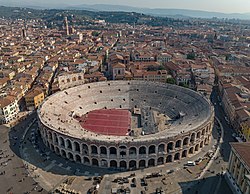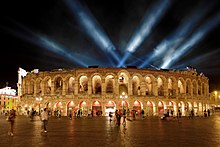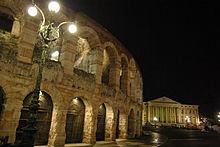You can help expand this article with text translated from the corresponding article in Italian. (July 2024) Click for important translation instructions.
|
| Verona Arena | |
|---|---|
 | |
| General information | |
| Type | Amphitheatre |
| Location | |
| Completed | AD 30; 1995 years ago (30) |
| Other information | |
| Seating capacity | 22,000 |



The Verona Arena (Italian: Arena di Verona, Italian: [aˈrɛːna di veˈroːna, aˈreːna -]) is a Roman amphitheatre in Piazza Bra in Verona, Italy, built in 30 AD. It is still in use and serves as a venue for large-scale opera performances.
It is one of the best preserved ancient structures of its kind. In ancient times, the arena's capacity was nearly 30,000 people. The stage for concerts and opera performances decreases the available capacity to a maximum of 22,000.
Amphitheatre

The building itself was built in AD 30 on a site which was then beyond the city walls. The ludi (shows and games) staged there were so famous that spectators came from many other places, often far away, to witness them. The amphitheatre could host more than 30,000 spectators in ancient times. The round facade of the building was originally composed of white and pink limestone from Valpolicella, but after a major earthquake in 1117, which almost completely destroyed the structure's outer ring, except for the so-called "ala" (wing), the stone was quarried for re-use in other buildings. Nevertheless, it impressed medieval visitors to the city, one of whom considered it to have been a labyrinth, without ingress or egress. Ciriaco d'Ancona was filled with admiration for the way it had been built and Giovanni Antonio Panteo's civic panegyric De laudibus veronae, 1483, remarked that it struck the viewer as a construction that was more than human.
Opera venue
The first interventions to recover the arena's function as an opera venue began during the Renaissance. Some operatic performances were later mounted in the building during the 1850s, owing to its outstanding acoustics.
In 1913, operatic performances in the arena commenced in earnest due to the zeal and initiative of the Italian opera tenor Giovanni Zenatello and the impresario Ottone Rovato. The first 20th-century operatic production at the arena, a staging of Giuseppe Verdi's Aida, took place on 10 August of that year, to mark the birth of Verdi 100 years before in 1813. The composers Puccini and Mascagni were in attendance. Since then, summer seasons of opera have been mounted continually at the arena, except in 1915–18 and 1940–45, when Europe was convulsed in war.
In modern times, at least four productions (sometimes up to six) are mounted each year between June and August. During the winter months, the local opera and ballet companies perform at the Teatro Filarmonico.
Modern-day travellers are advised that admission tickets to sit on the arena's stone steps are much cheaper to buy than tickets giving access to the padded chairs available on lower levels. Candles are distributed to the audience and lit after sunset around the arena.
Every year over 500,000 people see productions of the popular operas in this arena. Once capable of housing 20,000 patrons per performance (now limited to 15,000 because of safety reasons), the arena has featured many of world's most notable opera singers. In the post-World War II era, they have included Giuseppe Di Stefano, Maria Callas, Tito Gobbi and Renata Tebaldi among other names. A number of conductors have appeared there, too. The official arena shop has historical recordings made by some of them available for sale.
The opera productions in the Verona Arena had not used any microphones or loudspeakers until a sound reinforcement system was installed in 2011.
Arena di Verona Festival
Main article: Arena di Verona Festival| This section does not cite any sources. Please help improve this section by adding citations to reliable sources. Unsourced material may be challenged and removed. (July 2024) (Learn how and when to remove this message) |
Arena di Verona Festival is a summer festival of opera, inaugurated in 1913 with Giuseppe Verdi's Aida, to celebrate the centenary of the artist's birth.
Other uses

In recent times, the arena has also hosted several concerts of international rock and pop bands, among which Zucchero Fornaciari, who holds the record of the highest number of concerts in the location, 38 from 1989 to 2017, and the highest number of concerts during the same tour, 22 of the Black Cat World Tour, Roger Waters, Bruce Springsteen, Elisa, Eros Ramazzotti, Laura Pausini, Pink Floyd, Alicia Keys, One Direction, Simple Minds (whose concert film Verona was filmed at the venue during their Street Fighting Years Tour on 15 September 1989) Duran Duran, Deep Purple, The Who, Dire Straits, Scatman John, Mike Oldfield, Rod Stewart, Michael Flatley, Yanni, Sting, Pearl Jam, Radiohead, Peter Gabriel, Björk, Eiffel 65, Muse, Leonard Cohen, Elton John, Paul McCartney, Jamiroquai, Whitney Houston, Mumford & Sons, Kiss, Spandau Ballet, 5 Seconds Of Summer, Måneskin, 2Cellos, and Evanescence.
In 2020, following the cancellation of the Eurovision Song Contest, the Arena played host to Diodato, who had won the Sanremo Music Festival, for a special performance of his song 'Fai rumore' in the empty arena. Italy had been one of the favourites to win and the performance became one of the highlights of 'Europe Shine a Light'.
In 1981, 1984, 2010, 2019, and 2022, the arena hosted the podium and presentation of the Giro d'Italia.
From 25 September 2021 to 4 October 2023, the venue hosted "Arena Suzuki", an Italian television program of a variety of musical genres, broadcast in prime time on Rai 1, and presented by Amadeus.
The first game of 2023 CEV European Women's Volleyball Championships took place in the Arena. Home team and defending European champs Italy faced Romania in the first game of Pool B.
The closing ceremonies of the Milan—Cortina d'Ampezzo 2026 Winter Olympics, and the opening ceremonies of the 2026 Winter Paralympics, are scheduled to be hosted by the arena.
See also
References
- "Arena di Verona". 19 October 2015.
- altum lambyrintum in quo nescitur ingressus et egressus, quoted in Roberto Weiss, The Renaissance Discovery of Classical Antiquity, 1969:117 and note 7.
- Weiss 1969.
- Festivals in Italy 2009
- "Verona Opera Festival Outfitted with New Audio". AVTechnology. February 7, 2011. Archived from the original on March 14, 2012. Retrieved July 2, 2011.
- Videos > Verona - Dream Giver Redux, retrieved 2021-05-26
- "Tappa 21 - Giro d'Italia 2021 | Sito Ufficiale".
- Bosio, Enrico (2021-09-22). "Suzuki porta all'Arena di Verona i miti della musica". Rai Pubblicità. Robassomero. Retrieved 2025-01-05.
- "Milan Cortina 2026 dismisses report Olympic Opening Ceremony could be moved". www.insidethegames.biz. 2021-10-27. Retrieved 2023-03-03.
External links
- Verona Arena website, in English
- Photographs of Arena di Verona
- An article on Arena di Verona
- Live webcam on Verona Arena Archived 2011-05-30 at the Wayback Machine
- Verona Arena English Video Introduction
| Preceded byBeijing National Stadium Beijing |
Winter Olympics Closing Ceremony 2026 |
Succeeded byAllianz Riviera French Alps |
| Landmarks of Veneto | |
|---|---|
| Music venues in Italy | |
|---|---|
| Rome | |
| Milan | |
| Naples | |
| Turin | |
| Palermo | |
| Bologna | |
| Other cities |
|
| Venues of the 2026 Winter Olympics and Paralympics (Milano Cortina) | |
|---|---|
| Milan Cluster | |
| Valtellina Cluster |
|
| Cortina d'Ampezzo Cluster | |
| Val di Fiemme Cluster | |
| Verona | |
45°26′20″N 10°59′40″E / 45.43889°N 10.99444°E / 45.43889; 10.99444
Categories: